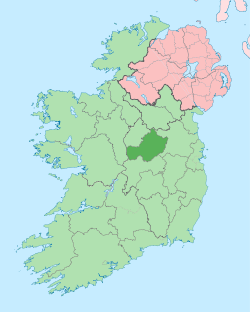Ballynacargy
| Ballynacargy Baile na Carraige | |
|---|---|
| Town | |
|
Ballynacargy | |
 Ballynacargy Location in Ireland | |
| Coordinates: 53°34′58″N 7°32′14″W / 53.5827°N 7.5372°WCoordinates: 53°34′58″N 7°32′14″W / 53.5827°N 7.5372°W | |
| Country | Ireland |
| Province | Leinster |
| County | County Westmeath |
| Government | |
| • Dáil Éireann | Longford–Westmeath |
| Population (2002) | |
| • Urban | 1,382 |
| Time zone | WET (UTC+0) |
| • Summer (DST) | IST (WEST) (UTC-1) |
Ballynacargy, or Ballinacarrigy, (Irish: Baile na Carraige) is a small village in County Westmeath, Ireland on the Royal Canal and the R393 regional road. The last official commercial navigation of the canal took place in 1955.
Public transport
Bus Éireann route 448 provides a link to Mullingar on Fridays only departing at 10.15 and returning from Mullingar at 13.30. The nearest railway station is Mullingar railway station approximately 15 kilometres distant. Until the evening of 24 August 2013 Bus Éireann route 118 (Dublin-Mullingar-Longford) served Ballynacargy on Saturdays only allowing passengers to travel into Longford for a few hours.[1][2]
History
The village primarily owes its existence to the Royal Canal which opened in 1817. The origins of the village go back much further. The first recorded reference to it dates from 1537 after the dissolution of the nearby monastery at Tristernagh Abbey. Attached to the monastery was a leper hospital, a rarity by that time. It is thought that the village initially grew with the decline of Kilbixy, an important town in County Meath 500 years ago.
The local parish is still called Kilbixy and is home to a mausoleum built by a Lord Sunderlin in 1798.
Northeast of the village are the ruins of Templecross Church from where the ruins of Tristernagh Abbey are visible. Templecross was converted to a Protestant church in the 17th century. The abbey, also known as the Priory of Kilbixy was founded in 1192 by Geoffrey de Constantine. An Augustinian priory, the abbey achieved some fame from its establishment until 1536 when the commissioners of the English King Henry VIII ransacked and destroyed it.
Notable people
- Joe Dolan (16 October 1939 – 26 December 2007) was an Irish entertainer, recording artiste, and pop singer. Chiefly known in Ireland for his association with showbands and for his innovative style and high pitched singing voice, he had a wide appeal with many international fans. His energetic and charismatic stage performances were well known as was his long standing advertising slogan: "There's no show like a Joe show". A 540-metre bridge was named after him: the Joe Dolan Bridge in Mullingar, opened officially 6 September 2010. There is also a statue of Dolan in his hometown of Mullingar.
- Robert Troy, Politician and Member of Dáil Éireann since 2011 as a representative of the Fianna Fáil party.

